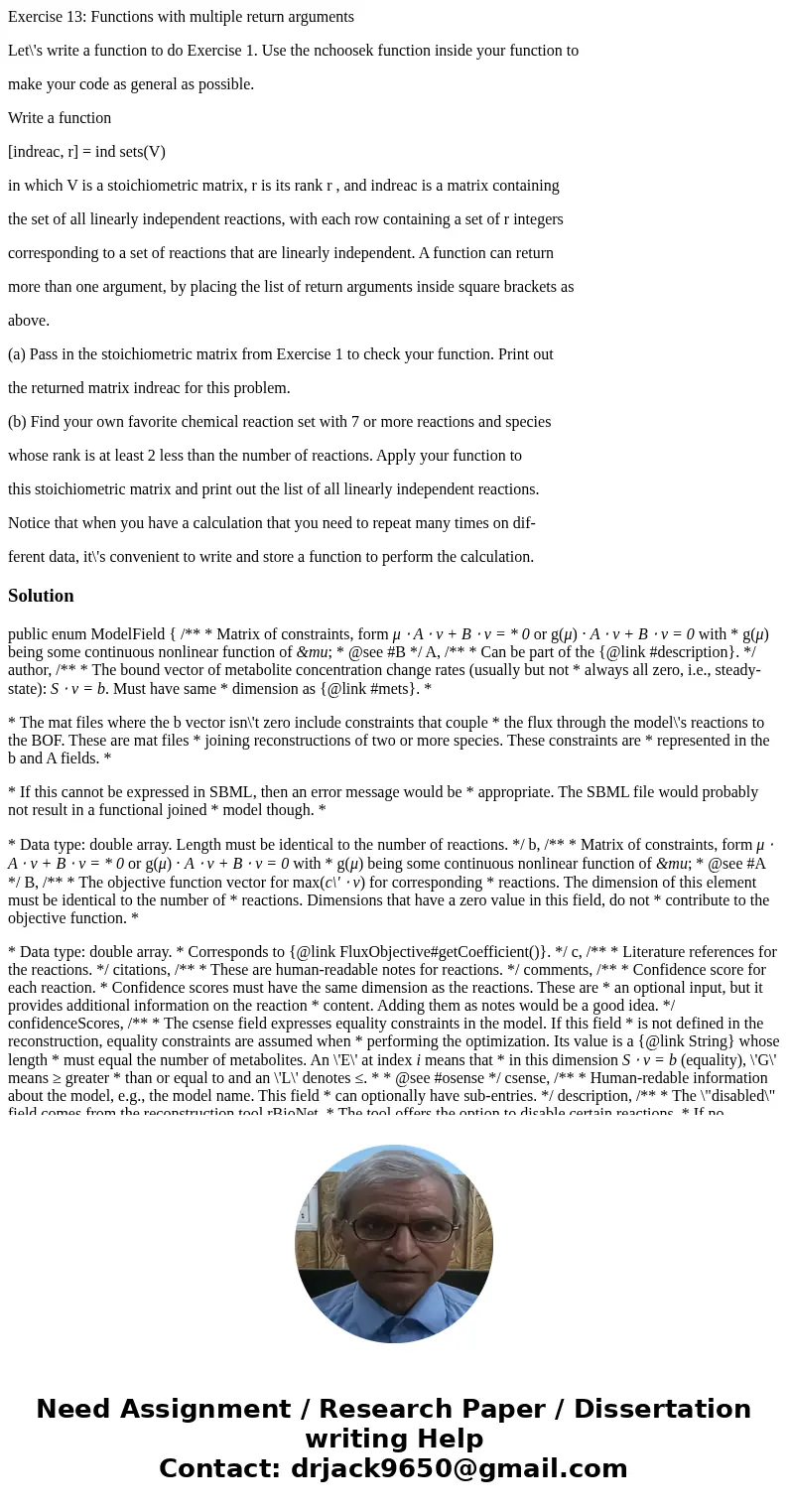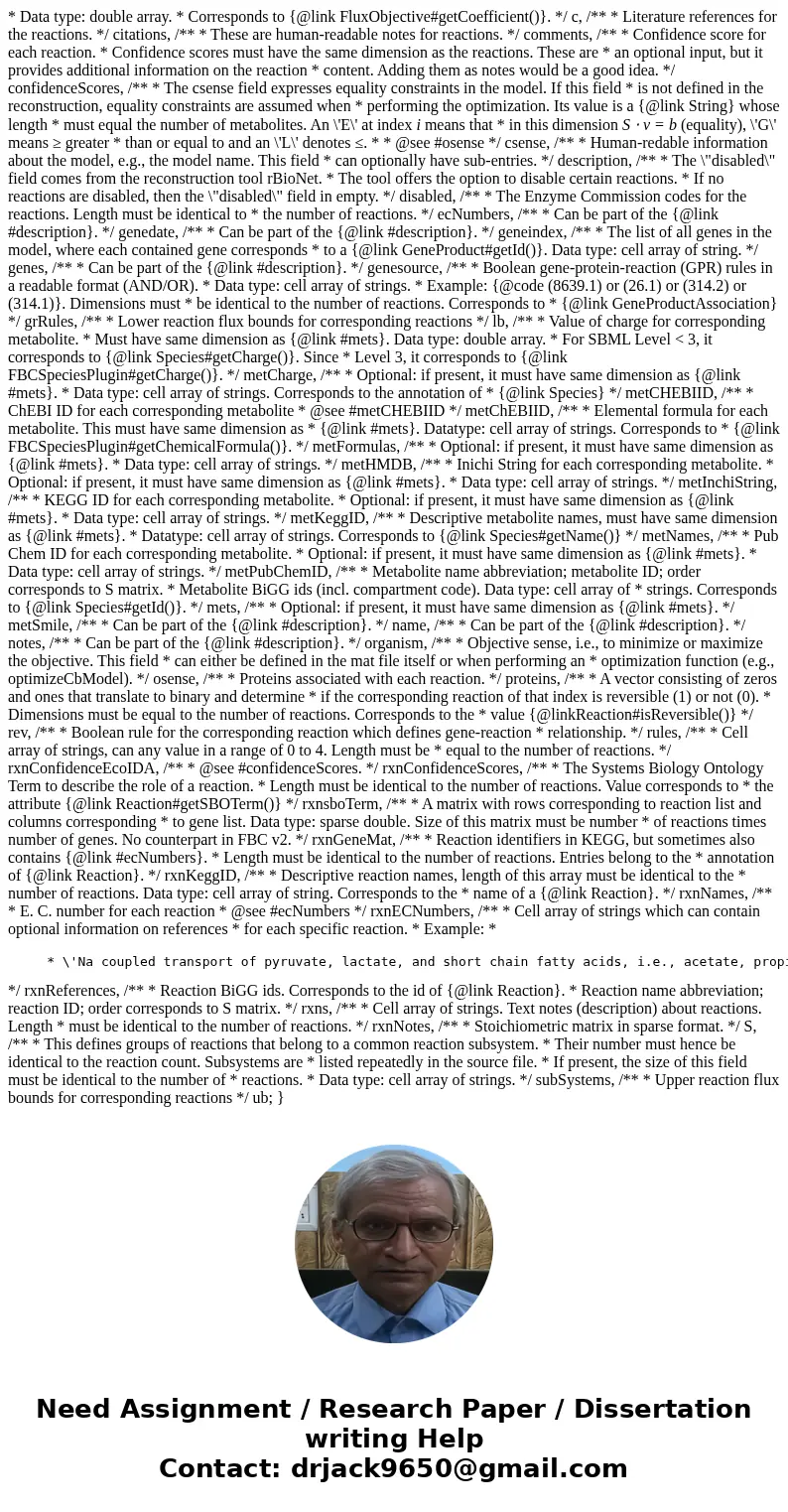Exercise 13 Functions with multiple return arguments Lets wr
Exercise 13: Functions with multiple return arguments
Let\'s write a function to do Exercise 1. Use the nchoosek function inside your function to
make your code as general as possible.
Write a function
[indreac, r] = ind sets(V)
in which V is a stoichiometric matrix, r is its rank r , and indreac is a matrix containing
the set of all linearly independent reactions, with each row containing a set of r integers
corresponding to a set of reactions that are linearly independent. A function can return
more than one argument, by placing the list of return arguments inside square brackets as
above.
(a) Pass in the stoichiometric matrix from Exercise 1 to check your function. Print out
the returned matrix indreac for this problem.
(b) Find your own favorite chemical reaction set with 7 or more reactions and species
whose rank is at least 2 less than the number of reactions. Apply your function to
this stoichiometric matrix and print out the list of all linearly independent reactions.
Notice that when you have a calculation that you need to repeat many times on dif-
ferent data, it\'s convenient to write and store a function to perform the calculation.
Solution
public enum ModelField { /** * Matrix of constraints, form μ ⋅ A ⋅ v + B ⋅ v = * 0 or g(μ) ⋅ A ⋅ v + B ⋅ v = 0 with * g(μ) being some continuous nonlinear function of μ * @see #B */ A, /** * Can be part of the {@link #description}. */ author, /** * The bound vector of metabolite concentration change rates (usually but not * always all zero, i.e., steady-state): S ⋅ v = b. Must have same * dimension as {@link #mets}. ** The mat files where the b vector isn\'t zero include constraints that couple * the flux through the model\'s reactions to the BOF. These are mat files * joining reconstructions of two or more species. These constraints are * represented in the b and A fields. *
* If this cannot be expressed in SBML, then an error message would be * appropriate. The SBML file would probably not result in a functional joined * model though. *
* Data type: double array. Length must be identical to the number of reactions. */ b, /** * Matrix of constraints, form μ ⋅ A ⋅ v + B ⋅ v = * 0 or g(μ) ⋅ A ⋅ v + B ⋅ v = 0 with * g(μ) being some continuous nonlinear function of μ * @see #A */ B, /** * The objective function vector for max(c\' ⋅ v) for corresponding * reactions. The dimension of this element must be identical to the number of * reactions. Dimensions that have a zero value in this field, do not * contribute to the objective function. *
* Data type: double array. * Corresponds to {@link FluxObjective#getCoefficient()}. */ c, /** * Literature references for the reactions. */ citations, /** * These are human-readable notes for reactions. */ comments, /** * Confidence score for each reaction. * Confidence scores must have the same dimension as the reactions. These are * an optional input, but it provides additional information on the reaction * content. Adding them as notes would be a good idea. */ confidenceScores, /** * The csense field expresses equality constraints in the model. If this field * is not defined in the reconstruction, equality constraints are assumed when * performing the optimization. Its value is a {@link String} whose length * must equal the number of metabolites. An \'E\' at index i means that * in this dimension S ⋅ v = b (equality), \'G\' means ≥ greater * than or equal to and an \'L\' denotes ≤. * * @see #osense */ csense, /** * Human-redable information about the model, e.g., the model name. This field * can optionally have sub-entries. */ description, /** * The \"disabled\" field comes from the reconstruction tool rBioNet. * The tool offers the option to disable certain reactions. * If no reactions are disabled, then the \"disabled\" field in empty. */ disabled, /** * The Enzyme Commission codes for the reactions. Length must be identical to * the number of reactions. */ ecNumbers, /** * Can be part of the {@link #description}. */ genedate, /** * Can be part of the {@link #description}. */ geneindex, /** * The list of all genes in the model, where each contained gene corresponds * to a {@link GeneProduct#getId()}. Data type: cell array of string. */ genes, /** * Can be part of the {@link #description}. */ genesource, /** * Boolean gene-protein-reaction (GPR) rules in a readable format (AND/OR). * Data type: cell array of strings. * Example: {@code (8639.1) or (26.1) or (314.2) or (314.1)}. Dimensions must * be identical to the number of reactions. Corresponds to * {@link GeneProductAssociation} */ grRules, /** * Lower reaction flux bounds for corresponding reactions */ lb, /** * Value of charge for corresponding metabolite. * Must have same dimension as {@link #mets}. Data type: double array. * For SBML Level < 3, it corresponds to {@link Species#getCharge()}. Since * Level 3, it corresponds to {@link FBCSpeciesPlugin#getCharge()}. */ metCharge, /** * Optional: if present, it must have same dimension as {@link #mets}. * Data type: cell array of strings. Corresponds to the annotation of * {@link Species} */ metCHEBIID, /** * ChEBI ID for each corresponding metabolite * @see #metCHEBIID */ metChEBIID, /** * Elemental formula for each metabolite. This must have same dimension as * {@link #mets}. Datatype: cell array of strings. Corresponds to * {@link FBCSpeciesPlugin#getChemicalFormula()}. */ metFormulas, /** * Optional: if present, it must have same dimension as {@link #mets}. * Data type: cell array of strings. */ metHMDB, /** * Inichi String for each corresponding metabolite. * Optional: if present, it must have same dimension as {@link #mets}. * Data type: cell array of strings. */ metInchiString, /** * KEGG ID for each corresponding metabolite. * Optional: if present, it must have same dimension as {@link #mets}. * Data type: cell array of strings. */ metKeggID, /** * Descriptive metabolite names, must have same dimension as {@link #mets}. * Datatype: cell array of strings. Corresponds to {@link Species#getName()} */ metNames, /** * Pub Chem ID for each corresponding metabolite. * Optional: if present, it must have same dimension as {@link #mets}. * Data type: cell array of strings. */ metPubChemID, /** * Metabolite name abbreviation; metabolite ID; order corresponds to S matrix. * Metabolite BiGG ids (incl. compartment code). Data type: cell array of * strings. Corresponds to {@link Species#getId()}. */ mets, /** * Optional: if present, it must have same dimension as {@link #mets}. */ metSmile, /** * Can be part of the {@link #description}. */ name, /** * Can be part of the {@link #description}. */ notes, /** * Can be part of the {@link #description}. */ organism, /** * Objective sense, i.e., to minimize or maximize the objective. This field * can either be defined in the mat file itself or when performing an * optimization function (e.g., optimizeCbModel). */ osense, /** * Proteins associated with each reaction. */ proteins, /** * A vector consisting of zeros and ones that translate to binary and determine * if the corresponding reaction of that index is reversible (1) or not (0). * Dimensions must be equal to the number of reactions. Corresponds to the * value {@linkReaction#isReversible()} */ rev, /** * Boolean rule for the corresponding reaction which defines gene-reaction * relationship. */ rules, /** * Cell array of strings, can any value in a range of 0 to 4. Length must be * equal to the number of reactions. */ rxnConfidenceEcoIDA, /** * @see #confidenceScores. */ rxnConfidenceScores, /** * The Systems Biology Ontology Term to describe the role of a reaction. * Length must be identical to the number of reactions. Value corresponds to * the attribute {@link Reaction#getSBOTerm()} */ rxnsboTerm, /** * A matrix with rows corresponding to reaction list and columns corresponding * to gene list. Data type: sparse double. Size of this matrix must be number * of reactions times number of genes. No counterpart in FBC v2. */ rxnGeneMat, /** * Reaction identifiers in KEGG, but sometimes also contains {@link #ecNumbers}. * Length must be identical to the number of reactions. Entries belong to the * annotation of {@link Reaction}. */ rxnKeggID, /** * Descriptive reaction names, length of this array must be identical to the * number of reactions. Data type: cell array of string. Corresponds to the * name of a {@link Reaction}. */ rxnNames, /** * E. C. number for each reaction * @see #ecNumbers */ rxnECNumbers, /** * Cell array of strings which can contain optional information on references * for each specific reaction. * Example: *
* \'Na coupled transport of pyruvate, lactate, and short chain fatty acids, i.e., acetate, propionate, and butyrate mediated by SMCT1 **/ rxnReferences, /** * Reaction BiGG ids. Corresponds to the id of {@link Reaction}. * Reaction name abbreviation; reaction ID; order corresponds to S matrix. */ rxns, /** * Cell array of strings. Text notes (description) about reactions. Length * must be identical to the number of reactions. */ rxnNotes, /** * Stoichiometric matrix in sparse format. */ S, /** * This defines groups of reactions that belong to a common reaction subsystem. * Their number must hence be identical to the reaction count. Subsystems are * listed repeatedly in the source file. * If present, the size of this field must be identical to the number of * reactions. * Data type: cell array of strings. */ subSystems, /** * Upper reaction flux bounds for corresponding reactions */ ub; }


 Homework Sourse
Homework Sourse